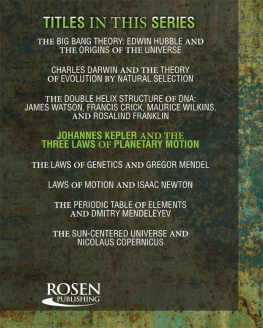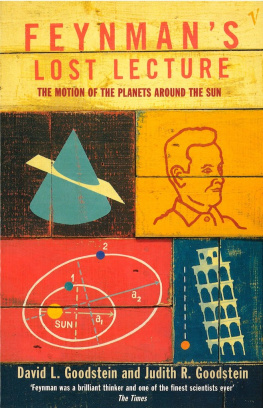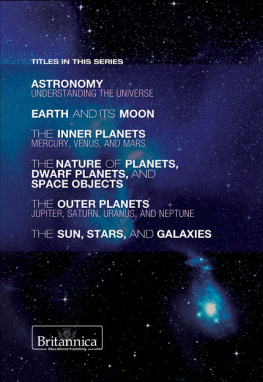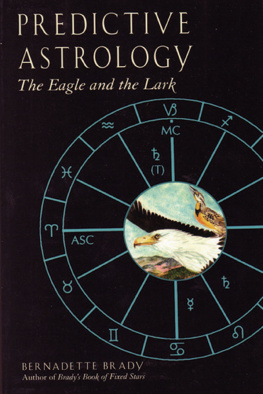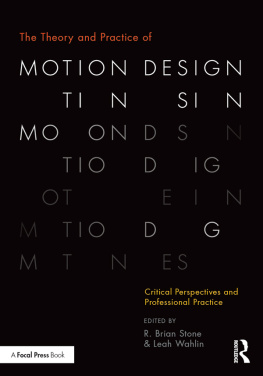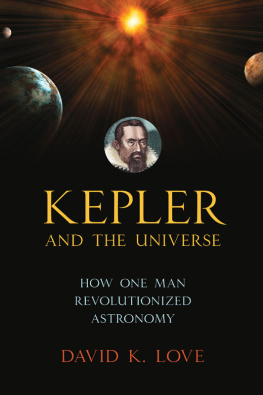The Ballet of the Planets
The Ballet of the Planets
On the Mathematical Elegance
of Planetary Motion
Donald C. Benson


Oxford University Press
Oxford University Press, Inc., publishes works that further
Oxford Universitys objective of excellence
in research, scholarship, and education.
Oxford New York
Auckland Cape Town Dar es Salaam Hong Kong Karachi
Kuala Lumpur Madrid Melbourne Mexico City Nairobi
New Delhi Shanghai Taipei Toronto
With offices in
Argentina Austria Brazil Chile Czech Republic France Greece
Guatemala Hungary Italy Japan Poland Portugal Singapore
South Korea Switzerland Thailand Turkey Ukraine Vietnam
Copyright 2012 by Oxford University Press
Published by Oxford University Press, Inc.
198 Madison Avenue, New York, New York 10016
www.oup.com
Oxford is a registered trademark of Oxford University Press
All rights reserved. No part of this publication may be reproduced,
stored in a retrieval system, or transmitted, in any form or by any means,
electronic, mechanical, photocopying, recording, or otherwise,
without the prior permission of Oxford University Press.
Library of Congress Cataloging-in-Publication Data
Benson, Donald C.
The ballet of the planets: on the mathematical elegance of planetary motion / Donald C. Benson.
p. cm.
Includes bibliographical references and index.
ISBN 978-0-19-989100-9 (hardcover: alk. paper) 1. Planetary theoryHistory. I. Title.
QB361.B46 2012
523.2dc23 2011033632
1 3 5 7 9 8 6 4 2
Printed in the United States of America
on acid-free paper
Dedicated to my wife, Dorothy, without whose help and loving encouragement this book would not be possible
CONTENTS
ACKNOWLEDGMENTS
I would like to thank the following people for reading the entire manuscript and making many important suggestions: Dorothy Benson, Ned Black, and Donald Chakerian. I also thank my anonymous reviewers for their invaluable suggestions.
INTRODUCTION
the celestial ballet is beheld
in its repeated performances
before our eyes.
Nicholas Copernicus, De revolutionibus (1543)
And first of all, astronomy taught that there are laws.these rules were discerned by Hipparchus, Ptolemy, Copernicus, one after the other, and finally, Newton Henri Poincar (18541912) The Value of Science (1907)
I grew up in a Los Angeles neighborhood from which the Griffith Observatory is visible, high on a hill to the north. I am sure that its presence had a subtle influence, turning my young mind toward science and mathematics. Eventually, mathematics became my passion and my profession. In this bookreturning to the source of my inspiration of long agoI will tell the story of an ancient astronomical problem, the problem of understanding planetary motion. Such understanding means giving the motion of the planets a mathematical structure.
I believe that this book would have interested me when I was a high school student who loved mathematics. I hope that it will be of interest to allincluding students, professionals, and hobbyistswho enjoy mathematics.
Early astronomy, the topic of this book, constitutes the birth of science and the forerunner of the technology that is such an important part of modern life ending the struggle for mere survival and giving you and me the time to read and write books. The motion of the planets was very puzzling to early scientists because, over a period of weeks, the positions of the planets relative to the fixed stars changed in a manner that was difficult to explain. This book looks at several early theories of planetary motionillustrating the development of mathematical models in the exact sciences. The first geometrical theories came from Greek astronomers in the fourth century BCE (although the Babylonians had earlier learned to predict planetary phenomena by using repeating arithmetic patterns). This book concludes with Isaac Newtons treatment of this problem in the seventeenth century, which, even today, is sufficient for the needs of the space program.
Planetary astronomy, like science in general, advanced through the interplay of observation and theory. Theory gives an abstract explanation of observation, and observation provides a critique that confirms, weakens, or denies the theory. Even without the stimulus of new observations, an old theory can be replaced by a new one that explains the old observations in a simpler or more general manner. The heliocentric theory of Copernicus is an example of a simpler new theory superseding a more complicated old one.
Although this book contains historical factsand I want them to be accurateI cannot claim that this is a history of planetary astronomy, for the following two reasons: first, I have not attempted to give a complete history of the subject. I have included some historical topics that I believe are relevant to the development of mathematical models of planetary motion. Second, I wish to discuss the ideas of astronomers of the pastin particular, how their ideas lead to the science of todaybut I do not feel the need to use their original presentations. In this book, I have selected from the history of astronomy a few ideas, mainly geometrical, that lead forward to the current science of the solar system. My choice of historical topics is eclectic and personal. I do not claim to give a complete history of planetary astronomy.
In a 1676 letter to Robert Hooke, Isaac Newton (16421727) wrote, If I have seen further it is only by standing on the shoulders of giants. In this book, I discussfrom the point of view of current, not ancient, sciencea few of the contributions of these giants, including Archimedes, Ptolemy, Copernicus, and Kepler, as well as Newton himself. I have selected contributions that led forward and made possible the science of today. The scientific methods and standards of the ancient scientists differed from those of today, but I leave that topic to the historians of science.
Naked-eye astronomy is uniquely suitable as an introduction to the exact sciences because there are no scientific prerequisites. The theoretical side of positional astronomy involves nothing deeper than elementary geometry. On the other hand, electromagnetism, quantum mechanics, and relativity involve deep concepts that are so far beyond ordinary experience that these topics are inappropriate as an introduction to the exact sciences for the nonspecialist. Furthermore, current concepts of cosmology for example, string theoryremain largely speculative, untested (perhaps untestable) by observation. Books on science for a general reader often tell what is true, not why it is true. Because the basic concepts in this book are not difficult, it will be possible to tell not only what is true but also why.
The development of the study of planetary astronomy cannot be understood without also telling the storybeginning with Archimedes (287212 BCE)of the parallel development of mechanics, the branch of physics dealing with the behavior of physical bodies subject to movement or force. These two threads of knowledge, astronomy and mechanics, become beautifully entwined in Newtons theory of universal gravitation.
Geometry plays the central role in all theories of planetary motion. Geometrical concepts are self-contained in this book, but I do assume a reader will have a background of high school algebra. Two geometrical curves are fundamental to the development of planetary astronomy: first epicyclic curves and later ellipses. I have devoted separate chapters to the mathematical properties of these curves.
Next page







